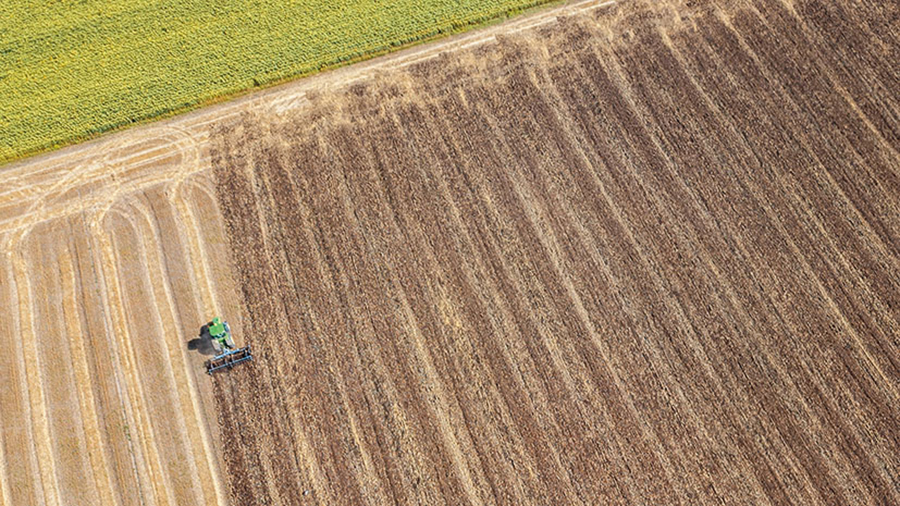Plan carefully to get back on track this autumn
25th July 2024
Hutchinsons technical manager, Dick Neale, and regional technical support manager, Alice Cannon, offer establishment advice following a washout 2023/24 season.

Soils, cropping plans, weed control programmes, and yield prospects have all taken a battering on many farms this year. Inevitably, there will be eagerness to get on with a new cropping year, but to do so requires careful planning to avoid any lasting legacy of an exceptionally wet season.
The starting point is to use the spade to examine soil conditions in individual fields. This allows you to identify any issues, and plan remedial measures, either before or after harvest.
There is no one answer for every field, as soil texture, cropping, drainage, cultivations, and many other factors all come into play.
Often in years like this, deep subsoiling is a go-to option, especially where field operations in wet conditions have left an obvious mark. While this may be appropriate in some situations, it is wrong to treat all soils the same.
Tramline ruts may well be compacted to depth, but if they are to remain tramlines next season, there is little urgency to rectify the issues – although deep ruts may need levelling with a cultivator.
The key is to identify exactly what issues need fixing and make plans from there. For example, is there compaction? How deep is it? Are there other drainage issues?
In many cases, field digs this season have shown that where soils have been flooded or waterlogged, depth of compaction can be quite shallow (e.g. 10–15cm), as the weight of water compressed the ground.
Farms that have moved from full inversion tillage to min-till systems may also find the zone most vulnerable to compaction has moved closer to the surface, away from the traditional ‘plough pan’ nearer 30cm deep.
Going in with a subsoiler at 30cm when compaction is only 10cm deep will not fix the problem and simply wastes time, fuel and money. For subsoiling to work, it must be at the correct working depth, so accurate machine setup and operation is essential. The point of the subsoiler wing should be just below the compaction zone, so compacted soil is physically lifted up and over the wing of the subsoiler foot, shattering in the process.
Tackling poor drainage
This season has clearly highlighted fields with underlying drainage issues, so now is a good opportunity to examine affected areas and plan actions to ‘future-proof’ that land.
In some cases, new field drains may be needed, but given the high capital cost, and limited number of already busy contractors, that may not be possible this season.
Mole ploughing could be an alternative, which when done properly can make a real difference to fields with poor drainage. Soil needs to be moist, and have a minimum clay content of 30% to hold the shape of the mole.
Moling must be planned carefully to identify where it will and won’t work, otherwise it risks moving water from one part of a field to another. Pay particular attention to slope angles, existing drains, and variations in soil texture across fields, which all influence effectiveness. Moling from a clay subsoil into a seam of sand, for example, may result in the sandy area becoming saturated and quickly losing structure, while going into a gravel area could actually help take water away.
Because of the need for damp soil, moling can start earlier in the season on uncropped land, unlike subsoiling which needs dry subsoil to shatter compacted layers.
It is usually done at 2m mole centres, at around 60cm deep, which itself will do much to lift and shatter soil, reducing the need for additional subsoiling.
Place for ploughing?
Although recent years have seen a significant move away from conventional ploughing, it could help alleviate shallower compaction, while also aerating soils.
It must be done well though, to the correct depth, and with full inversion. Extra care is needed on heavier soils, where drainage may be poor, as it can be more challenging to create a seedbed – particularly if land is ploughed wet and bakes dry, potentially doing more harm than good.
Tackle grassweeds
Grassweeds are another big consideration this autumn, particularly where growers plan to drill early – possibly with a second, or third-year cereal. Additionally, control on some farms has been compromised by the weather, leading to higher seed return.
If planning to drill early, be sensible and consider black-grass and other grassweed risks.
At the Hutchinsons Cambourne black-grass site and elsewhere, we are seeing black-grass dynamics changing towards slightly later germination in autumn and spring – not surprising as the weed adapts to concerted efforts over recent years to tackle late September/early October populations.
If black-grass is not germinating in September and early October, drilling earlier should allow a more vigorous wheat crop to be established ahead of it, but this must be supported with a sequence of well-timed residual herbicides to control late-emerging populations.
Some products must be applied pre-emergence of crops (e.g. tri-allate), which offers a good starting point, but follow this with strong residual chemistry in mid-October, post-emergence of the crop, but still pre-emergence of black-grass, and plan for another application pre-Christmas or in spring.
There is no one-size-fits-all solution, and consider other grassweeds too; take time to understand the problems and use this information when planning cultivations, cropping, drilling dates, etc. Brome for example needs managing differently depending on whether it is soft/meadow brome or sterile brome.
Read more arable news
